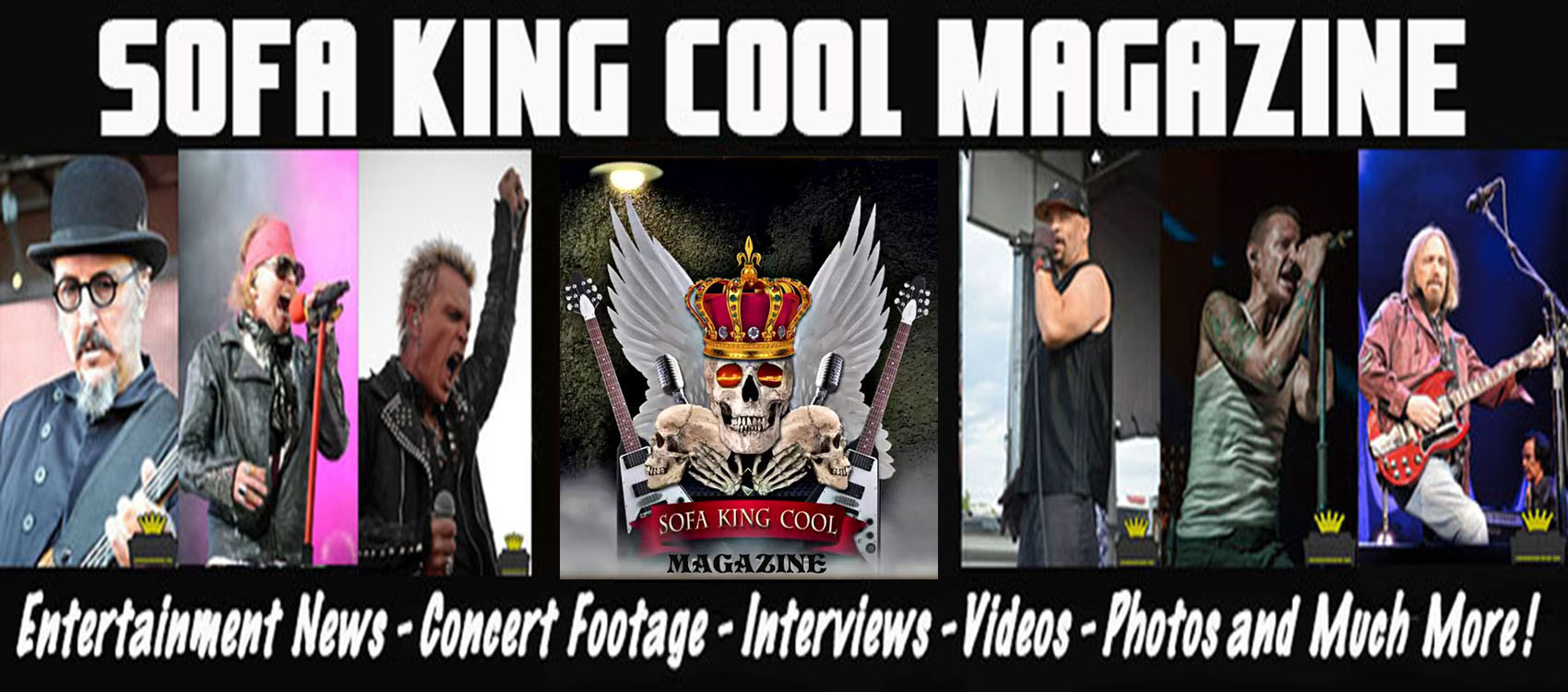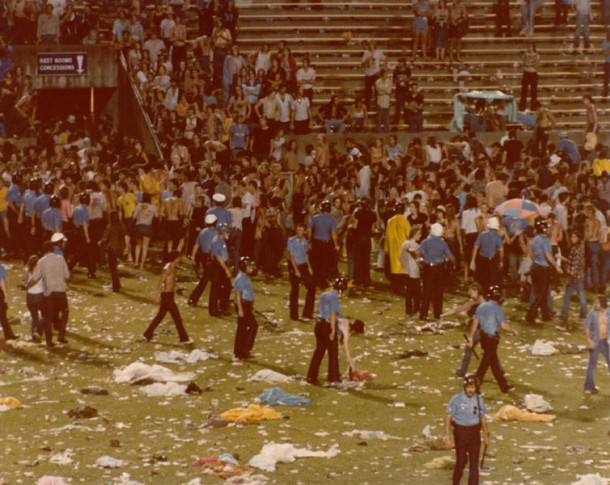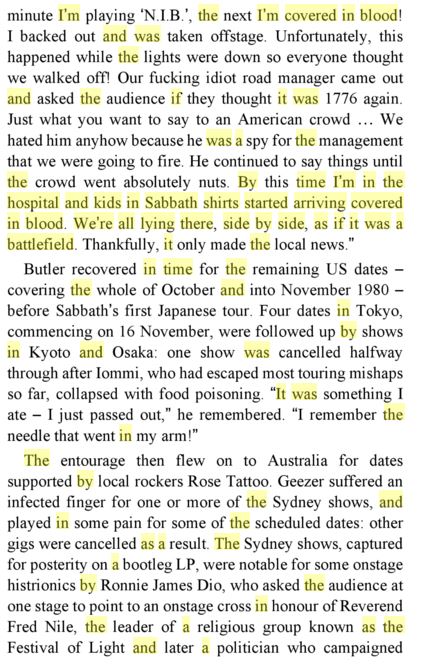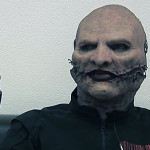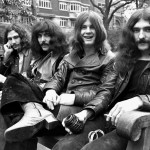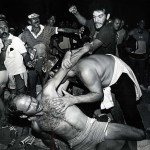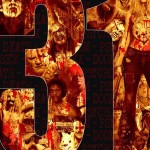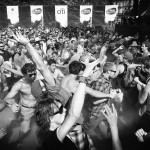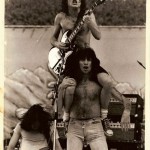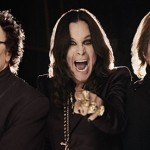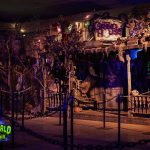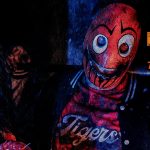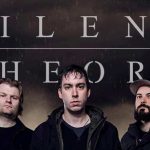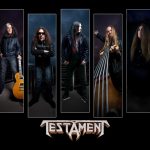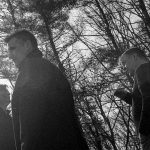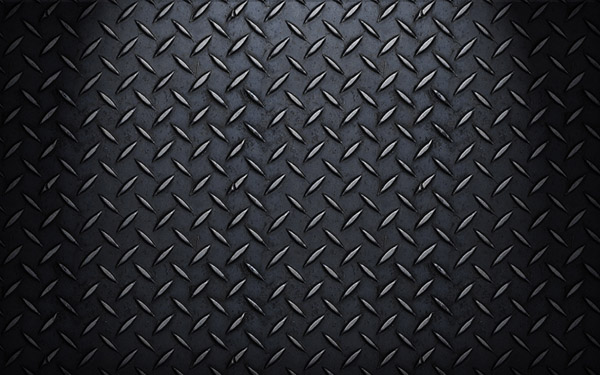The Most Terrifying Hard Rock & Heavy Metal Concert Riots and Mishaps
Rock-and-roll has been accused of inciting fans to mass violence from the days of Chuck Berry, Little Richard, and Elvis onward. One description often employed, not always inaccurately, has been “riotous.”
Came 1958, the “r”-word took on some gravitas after Bill Haley and His Comets toured Europe, where “Rock Around the Clock” drove concertgoers in London and especially Berlin to run wild, trash auditoriums, and physically clash with authority figures.
Rock, rioting, and mass panic have unfortunately mixed throughout the decades, occasionally to horrific results. Here are some of The Most Terrifying Hard Rock & Heavy Metal Concert Riots and Mishaps
Black Sabbath in Milwaukee (1980)
Just three songs Black Sabbath’s set on the Milwaukee stop of the Heaven and Hell tour, a hurled bottle clocked bassist Geezer Butler in the skull.
“I think I was doing the intro to ’N.I.B.’ and I heard something hit a cymbal,” Geezer recalled. “Then I was hit in the head. One minute I’m playing ’N.I.B.,’ the next I’m covered in blood! I backed out and was taken off stage. Unfortunately, this happened while the lights were down so everyone thought we walked off! Our f—king idiot road manager came out and asked the audience if they thought it was 1776 again. Just what you want to say to an American crowd!”
The show ended immediately and Butler still pins the ensuing chaos on that bigmouth road manger. “He continued to say things until the crowd went absolutely nuts,” Geezer said. “By the time I’m in the hospital and kids in Sabbath shirts started arriving covered in blood. We’re all lying there, side by side, as if it was a battlefield.”
Iron Maiden in Bogota, Colombia
On May 8, 2009, raucous gatecrashers at Simon Bolivar park jeopardized the good time of the 25,000 other Maidenheads who simply came to rock.
Brawls with police turned so wild that authorities called in military troops to quell the disturbance. Ultimately, cops arrested 111 people and one officer required facial reconstructive surgery.
Fortunately, the situation subsided early enough for Iron Maiden to hit the stage on schedule, and kick off the show with “Aces High.”
Alice Cooper in Toronto (1980)
The dawn of the 1980s proved to be a challenging time for Alice Cooper, both professionally and personally. He adapted to New Wave with the album Flush the Fashion, but his alcohol and drug issues nearly killed him—repeatedly.
Such internal strife came to a head on August 19, 1980, when 13,000 fans waited 90 minutes for Alice to take the stage after opening act Zon (we had to look them up, too). Someone announced that Alice was delayed due to a luggage mix-up at the airport. Then rumors spread throughout the crowd that Alice had been spotted getting drunk in a Toronto bar at show time. Tension mounted.
When guitarist Dick Wagner finally announced that Cooper had fallen ill and that the show was cancelled, the audience rose up in crazed rebellion.
Thirty-five years later, Alice, now sober for decades, swears he really had just gotten sick. “It was the first show I had missed in 15 years,” he said. “I have bronchial asthma; I was born with it. I hadn’t had an attack since I was six years old, but I arrived in Toronto that day, was in full costume and make up and couldn’t walk across the room.”
Metallica – Santiago, Chili
Nobody loves heavy metal more than South American headbangers, so when they launch a heavy metal riot, they really make it count.
When Metallica returned to Chile for the first time in a decade to play the 55,000-capacity Club Hipico horseracing stadium, more than 2,000 ticketless fans hurled themselves through the gates to get inside.
As hundreds of Metallica fans were left outside the gates due to not having tickets to gain entry, they began surging forward. Military showed up to calm things down.
Some made it, most didn’t. All, however, felt the wrath of the Caribeneros, Chile’s paramilitary law enforcement division, resulting in 160 arrests amidst insane brawling and head-busting outside the venue.
Guns N’ Roses in St. Louis (1991)
Technically, 1991’s notorious Guns N’ Roses incident in St. Louis took place at the Riverport Amphitheater in the nearby Maryland Heights, Missouri. It’s since been dubbed the “Riverport Riot” or, in keeping with the song Axl Rose cut short from the stage, the “Rocket Queen Riot.”
GNR was fifteen songs in when Rose stopped belting to point out a camera in the audience. “Take that! Take that!, Get that guy and take that!” Axl yelled at security guards until finally declaring, “I’ll take it, godammit!”
Rose then jumped into the crowd, knocked the amateur photographer to the ground, and he did indeed seize the camera amidst the dust-up. Returning to the stage, Axl announced, “Well, thanks to lame-ass security, I’m going home!” He slammed down the microphone and walked off.
The audience went berserk, decimating the amphitheater. Dozens suffered injuries, many serious. Later in 1991, Guns N’ Roses marked the occasion in the liner notes for Use Your Illusion with the message: “Fuck you, St. Louis!”
Guns N’ Roses and Metallica in Montreal (1992)
In terms of rock concert disasters, the GNR-Metallica Montreal debacle ranks high among the most heinous.
First, Metallica’s set was cut short after frontman James Hetfield suffered life-threatening third-degree burns from a pyrotechnic mishap.
Following that mass trauma, Axl Rose deigned to one-up the audience despair and frustration by taking more than two hours to come on stage. Once there, the band played for what most accounts say was about 15 minutes before Rose proclaimed, “This will be our last show for a long time!” He then, as Axl does, stormed off the stage.
An estimated 2,000 of the 53,000 concertgoers ran amuck, destroying property in and out of the stadium, looting everything in sight, and injuring dozens in the process. Montreal police used tear gas to dispel the mob.
Axl maintains he acted rationally, saying: “We had just stopped the tour because I had throat problems. Came back, and I realized, ‘I’m gonna hurt myself.’ I told Slash, ‘Two more songs, if we can’t get it fixed, I gotta go.’ We did more than two more songs, and finally I was just, like, ‘I don’t know what to do.’ I looked over and Gilby was like, ‘Dude, I can’t hear.’ And Duff was like, ‘I can’t hear either.’ We had a little huddle, and we were like, ‘We’re outta here.’”
Rage Against the Machine – Minneapolis, MN
Trouble broke out on downtown Minneapolis streets and police arrested 102 people who had attended the concert, according to the Joint Information Center which is coordinating security in connection with the Republican National Convention in St. Paul.
Frank Zappa at the Montreux Casino (1971)
On December 4, 1971, Frank Zappa and the Mothers of invention played the Montreux Casino in Switzerland. Rock history was made—all due to “some stupid with a flare gun.”
The show had been going well for 80 minutes when a fan fired a flare gun into the casino’s wooden roof, which immediately went up in flames (some in attendance say the young man was actually just throwing lit matches).
Initially, the band joked about the blaze from the stage, with singer Howard Kaylan even quipping, “Fire! Arthur Brown in person!” Rapidly, though, the danger became real.
Fans hurled themselves through the venues giant plate glass windows, while firefighters responded quickly, coming through the walls with axes. According to a fan who had been in attendance: “The glass smashed to the ground, and all the people in the front started to jump out. The building was on the second floor, or at least half a floor up, so it was quite a jump.”
The casino burned to cinders but, amazingly, the only human injuries were minor.
Deep Purple, who had also been on hand, famously immortalized the inferno with their rock anthem, “Smoke on the Water.”
Rolling Stones at Altamont Speedway (1969)
December 6, 1969 is a day that lives in rock infamy. As unflinchingly chronicled in the masterful 1970 documentary Gimme Shelter, the Rolling Stones free concert at California’s Altamont Speedway proved to be a living—and dying—nightmare.
Hundreds of thousands descended on the open field to witness the daylong festival, intended to be “Woodstock West,” that also featured Santana, Jefferson Airplane, and Crosby, Stills, Nash, and Young.
Trouble started before the first not was plucked, specifically in the form of the “security” that had been hired for the show: the hippie-hating Hell’s Angels motorcycle club. Compounding that questionable decision was that promoted paid the gang with LSD and beer.
Amidst freezing, miserable weather, artists made it to the stage while the Angels pummeled the hell out of concertgoers, often with billiards cues. When Jefferson Airplane’s Marty Balin leapt from the stage to break up one such melee, the bikers knocked him unconscious.
The pressure cooker situation reached its apocalyptic combustion point during the Stones’ late-night set. The freezing, hungry, insanely stoned crowd took on a terrifying life of its own, and the Hell’s Angels responded by stomping out the last traces of Flower Power in the brutal, unrelenting manner of… indeed, the Hell’s Angels. The footage in Gimme Shelter is as frightening as any horror film.
The air of universal hatred repeatedly flared into violence, and ultimately culminated with an 18-year-old concertgoer Meredith Hunter drawing a pistol, then immediately getting stabbed to death by a Hell’s Angel.
Remarkably, after the show, Keith Richards called Altamont, “on the whole, a good concert.”
Pearl Jam at Roskilde (2000)
Denmark’s annual open-air Roskilde festival is one of the largest such gatherings in all of rock. In 2000, it also turned into one of the most tragic.
After Pearl Jam kicked off their set, a 100,000-strong throng rushed through the muddy field toward the stage, crushing nine concertgoers to death, and seriously injuring 23 others.
“It was chaos,” PJ frontman Eddie Vedder said. “Some people were yelling ‘thank you.’ Others, who weren’t in bad shape, were running up and saying ‘hi.’ Then someone was pulled over, laid out and they were blue. We knew immediately it had gone on to that other level.”
Pearl Jam has honored the deceased throughout the years since the tragedy, withband members staying in touch and even becoming close friends with their loved ones.
The Who in Cincinnati (1979)
The Who tragedy in Cincinnati was not a riot in that crowd members turned on the event in anger; rather it was a tragic, soul-scarring mishap resulting from misguided policies and fans simply herded in without proper forethought given to their safety.
Cincinnati’s Riverfront Coliseum boasted a “festival seating” policy when the Who came to town on December 3, 1979. That meant that, upon admission, 14,770 pumped-up fans could charge as fast and as far as they could toward the front of the venue to get the best view. That’s exactly what happened. The crazed crowd unknowingly trampled eleven of their fellow concertgoers to death.
Hoping to stave off an even larger riot, Cincinnati Mayor Ken Blackwell advised that both the show go on as scheduled and that the Who not be informed of the horror until after the performance. Both proved wise decisions.
Afterward, devastated Who frontman Roger Daltrey told the news: “There’s no words to say what I feel. I’m a parent, as well. I’ve got a boy of 15 and two little girls. All I can say is: I’m sorry for what’s happened.”
The city quickly banned festival seating after the disaster and TV’s great rock-and-roll sitcom WKRP in Cincinnati even did a tasteful episode about the incident.
Woodstock ’99 (1999)
The irony of Woodstock ’99 celebrating the thirtieth anniversary of the original “music, peace, and love” festival can only be described as savage. Although just one accidental death was reported, the level of sexual assault among the crowds was so unchecked that the event has come to be called “Rapestock.”
Everything else that could have gone wrong absolutely did. The festival took place on the scorched tarmac and concrete of upstate New York’s Griffiths Air Force base during a heat wave. Promoters installed just a handful of drinking fountains for the crowd of 220,000 and then charged $4 for a bottle of water.
Amidst thirst and physical misery, predators set upon women in grotesque numbers (one, of course, is too many). Moshing and crowd-surfing turned into felonious assaults by the hundreds. A total of 500 police and state troopers attempted to keep order. Security volunteers and other staffers simply walked off the job.
The masses finally erupted during Limp Bizkit’s performance, specifically during “Break Stuff.” The audience took that direction literally.
Finally, during the Red Hot Chili Pepper’s closing set, the band unwisely covered Jimi Hendrix’s “Fire.” Blazes ignited all over the concert site and full-scale rebellion erupted amidst flaming debris and thirsty rioters liberating water bottles, then torching the vendor stands.
There was no Woodstock 2009 and, we imagine, there won’t be a 2019 edition either.
Great White at The Station in Rhode Island (2003)
On February 20, 2003, one hundred fans who came out to have a good time with ’80s glam metal band Great White lost their lives when the venue they were playing exploded in flames. On top of the deaths, 230 suffered injuries, many of them severe. 132 others made it out intact and alive—at least physically.
The Great White Station fire was not a riot the way other shows were when fans rose up in mass rage. As with the Who tragedy in Cincinnati, these innocent victims perished while simply trying to survive.
On-stage pyrotechnics lit up the Station nightclub in West Warwick, Rhode Island. Flames entirely devoured the building in five-and-a-half minutes. Fans initially thought the sparks and subsequent flames were part of the stage show. Vocalist Jack Russell saw the flames, stopped singing and said, “Wow, that’s not good.”
The crowd of 432 rushed to the club’s four exits, resulting in crushed bodies, confusion, and suffocation as the inferno raged. Numerous other doors were locked shit.
Three years later, Great White tour manager Daniel Biechele, who lit off the fireworks, pleaded guilty to 100 counts of manslaughter. He was sentenced to 15 years, with the possibility of parole in 2007. Many of the victims’ loved ones forgave Biechele and supported the seemingly light sentence, acknowledging that he simply made a tragic, horrific decision with no intention of hurting anyone. He got out in 2008.
Damageplan In Columbus, Ohio
On December 8, 2004, Abbott was shot onstage while performing with Damageplan at the Alrosa Villa in Columbus, Ohio. Moments into the band’s set, 25-year-old former marine, Nathan Gale, using a 9 mm Beretta 92FSpistol, shot Abbott three times in the head, killing him instantly. Some in attendance initially believed the shooting was part of the act, but as Gale continued shooting, the audience quickly came to the realization that the event was not staged. Having fired a total of fifteen shots, Gale killed a total of four people while wounding seven others.
Jeff “Mayhem” Thompson, the band’s head of security, was killed tackling Gale, as was Alrosa Villa employee Erin Halk. Audience member Nathan Bray was killed while trying to perform CPR on Abbott and Thompson. It was rumored that one crowd member leapt in front of the gunman, saving the lives of several band members. Damageplan drum technician, John “Kat” Brooks, was shot three times as he attempted to get the gun away from Gale, but was overpowered and taken hostage in a headlock position. Tour manager Chris Paluska was also injured.
Seven police officers came in the front entrance and moved toward the stage. Officer James Niggemeyer came in through the back door, behind the stage. Gale only saw the officers in front of the stage; he did not see Officer Niggemeyer, who was armed with a 12 gauge Remington 870 shotgun. He approached Gale from the opposite side of the stage to avoid hitting the hostage and fired a single shot just as Gale looked towards Niggemeyer, striking Gale in the face with eight of the nine buckshot pellets, killing him instantly. Gale was found to have had 35 rounds of ammunition remaining.
Two fans administered CPR on Dimebag until paramedics arrived, but were unable to revive him and he was pronounced dead at the scene.
Early theories of motive suggested that Gale, who was a Pantera fan, might have turned to violence in response to the breakup of the band, or the public dispute between Abbott and Pantera singer Phil Anselmo, but these were later ruled out by investigators. Another theory was that Gale believed Abbott had stolen a song that he had written. About 6 months prior to the shooting, Gale got into an altercation at a Damageplan concert in Cincinnati where he damaged $5,000 worth of equipment while being removed from the stage by security.
WORLD SERIES OF ROCK – 1979
The infamous Game 1 of the 1979 World Series of Rock starred heavy hitters Aerosmith, Ted Nugent, Journey, Thin Lizzy, AC/DC and Scorpions. Gates opened at noon for the hardest and most notorious WSOR thus far.
For the uninitiated, The World Series of Rock was a day long, multi-act summer rock concert series held at Cleveland Municipal Stadium, home![]() of The Indians and Browns. Belkin Productions staged the general admission event from 1974 through 1980. These shows were notorious for not only their arena rock spectacles but also the huge, rowdy crowds sometimes reaching up to 88,000 people.
of The Indians and Browns. Belkin Productions staged the general admission event from 1974 through 1980. These shows were notorious for not only their arena rock spectacles but also the huge, rowdy crowds sometimes reaching up to 88,000 people.
Even by the previous concerts standards this show is noted for it’s intensity, and is often on top 10 lists of most violent concerts due to incidents inside and out of Cleveland Municipal Stadium July 28th. Since these shows were all general admission![]() , fans would camp outside the old Lakefront Stadium to get the best possible seats thus becoming a target for criminals,etc…There were at least eight robberies reported and numerous incidents of theft, vandalism and gang violence. The media reported that five people were shot including one fatality. Also one other fatality allegedly occurred inside when someone climbed and then fell off the backstop. Belkin Productions then rescheduled a concert for August 19th that year and, under pressure from city officials, canceled it altogether. Putting the blame mostly on lack of safety, the last World Series of Rock took place on July 19, 1980.
, fans would camp outside the old Lakefront Stadium to get the best possible seats thus becoming a target for criminals,etc…There were at least eight robberies reported and numerous incidents of theft, vandalism and gang violence. The media reported that five people were shot including one fatality. Also one other fatality allegedly occurred inside when someone climbed and then fell off the backstop. Belkin Productions then rescheduled a concert for August 19th that year and, under pressure from city officials, canceled it altogether. Putting the blame mostly on lack of safety, the last World Series of Rock took place on July 19, 1980.
MONSTERS OF ROCK – 1988
The Monsters of Rock Festival was an annual one-day event that celebrated the best in hard rock and heavy metal music for almost 30 years. However, in 1988, the festival was marked by tragedy when two attendees were killed during the show, crushed to death during Guns N’ Roses’ set.
As with many of the other deaths by asphyxiation at concerts, the cause was unclear. Attendance at Monsters of Rock had grown since its creation in 1980, and by 1988 a crowd of over 100,000 was squeezed into Donington Park in England.
With the situation compounded by muddy weather and the sloping ground, footing was uncertain in front of the stage, and fans reported suffering injuries in the crush. The year after the deaths, horrified promoters cancelled Monsters of Rock. However, the festival made a return in 1990, with a lower limit on the number of people allowed to enter the grounds.
On August 20, 1988, two people were tragically trampled to death during Guns N’ Roses‘ performance at the Monsters of Rock festival in England. As the band began their set, the 100,000-person crowd surged forward.
Although Axl Rose addressed the crowd in an attempt to get them to calm down, his words were unable to prevent the deaths. GN’R were unjustly vilified for the incident by the media, but the head of security for the festival defended the band, who stopped their performance when the environment became too dangerous.
MARILYN MANSON – 2003

A Marilyn Manson performance in Kansas City, Missouri, on Thursday night ended in chaos when the crowd rioted following the show’s abrupt cancellation due to safety concerns.
The band was only two songs into its outdoor set at the Freakers Ball at the Kansas City International Raceway when the barrier at the front of the stage broke from the weight of the crowd pushing against it, police said.
The show was put on hold while the venue’s security team, Private
Systems Security, scurried to fix the barrier. The structure was
repaired after 30 minutes, and Manson resumed. But before he finished
another song, the barricade broke again, and at about 10 p.m. the
promoter canceled the concert.
“Even though the show was stopped twice for safety reasons, we wanted
nothing more than to continue to play,” Marilyn Manson said in a
statement. “Although we were not allowed to finish the show, we
understand that safety needs to come first.”
Many audience members weren’t so understanding. Although most of the
12,000 fans headed for the exits, choruses of boos, lots of swearing
and numerous fights erupted. Then, according to police, between 2,000
and 3,000 people began rioting in front of the stage. When it became
clear that Private Systems couldn’t control the mob, they called in the
Kansas City police, and an estimated 130 officers responded to the
scene in full riot gear.
The police formed a long line and ushered concertgoers toward the exit.
The orderly procession was interrupted when a group of fans started
throwing rocks, beer bottles and bottles filled with urine at the
officers, who responded by firing pepper spray at the unruly fans,
according to a police spokesperson. One officer was struck in the
finger and six fans suffered minor injuries and were transported by
ambulance to nearby hospitals, police said. Nine fans taken into
custody were released once they had calmed down.
One disgruntled audience member was arrested for trying to hit a traffic officer with his car. Nine police cars were damaged in the altercation. The Freakers Ball also featured Seether, S.T.U.N., Mushroomhead and Memento.
SUICIDE AND ELVIS COSTELLO
SAN BERNARDINO PUNK RIOT – 2006

The skinhead subculture has long been divided when it comes to race, with both pro-racist and anti-racist groups. And on March 4, 2006, at a concert in San Bernardino, California, at the National Orange Show Events Center, tensions between the two sides boiled over.
After a brawl outside involving neo-Nazi and anti-racist skinheads, fans entered the venue to find a skinhead chanting “white power” slogans. The angry crowd pelted him with debris, and security was forced to place him behind a fence to stop the other punks from tearing him to pieces. Eventually, weight of numbers prevailed, and an angry mob stormed the fence and attacked the young neo-Nazi, who during the chaos was stabbed.
Emergency services attempted to restore order by releasing tear gas at the scene, as well as inside the venue itself where no violence had occurred. This prompted angry concertgoers to retaliate, and a rampaging mob of 1,500 punks stormed from the building, overturning police cars and smashing the windows of local businesses.
The final toll for the riot was the serious injury of two concertgoers, four police injuries, at least 12 arrests, and $500,000 in property damage.
FAMILY VALUES TOUR – 2006

As part of the 2006 Family Values tour, heavy metal band Korn was headlining a performance at the HiFi Buys Amphitheater in Atlanta, Georgia on July 30. From the beginning, the show was marred by drunkenness, with a group of rowdy fans scuffling with other concert attendees.
During Deftones’ set, two fans had a confrontation that quickly turned into a scuffle. There are conflicting accounts as to what triggered the fight. Most news stories report that 25-year-old Michael Scott Axley stole 30-year-old Andy Richardson’s cap. But some also claim that Richardson had asked Axley to be careful around the pregnant woman and mentally challenged child whom he was with.
The result was that Axley lashed out, knocking Richardson over with one punch and killing him when the latter’s head made contact with the concrete floor. Axley was imprisoned for 10 years owing to his violent action – and, perhaps, all because of a hat.
Atari Teenage Riot – Berlin May 1st 1999
Beverly Hills Supper Club Fire, Deaths: 165
May 28, 1977 – Southgate, KY. USA
The Beverly Hills Supper Club was a sprawling maze of a club just across the bridge from Cincinnati, OH. It was possible to have several events going at the same time as was the case on the night of the fire — simultaneous banquets, receptions and larger events like the John Davidson concert — all connected by narrow passageways within the same structure.
A Cincinnati channel WLWT program about the fire including original footage and eyewitness accounts:
This nine day festival, according to several sources, was meant to promote the reputation of Morocco as a modern nation. Many international stars played the event including Stevie Wonder, Kylie Minogue, and Ennio Morricone. On the final night as the festival came to an end, after a set by Moroccan singer Abdelaziz Stati, 11 people were crushed to death.
Reuter’s video:
According to BBC, attendees blamed the tragedy on the police who closed several exits, ushering the crowds through others “that were not destined for the purpose.” The official line was that fans, too eager to leave, climbed fences, and one of them collapsed, causing the 11 deaths.
The Doors The Chicago Coliseum Concert 1968
On May 10, 1968 a riot broke out at The Doors concert at the Chicago Coliseum, in what may have been the first consciously created riot by Jim Morrison. Just a few weeks earlier Morrison had asked for an advance from Elektra to buy out their management team. They hired Bill Siddons, only 19, as manager, sound technician Vince Treanor was promoted to become the band’s new road manager, and Leon Bernard became acting assistant.
Morrison was at the point where he despised the band and was pushing all the buttons in a self destructive path that didn’t end until his death in 1971.
Reacting to alleged abuse of audience members by policemen, Morrison took the stage and was greeted by an eruption from the crowd as The Doors played songs most suited for stirring a reaction from the crowd, Unknown Soldier, Break on Through, Five to One, and When The Music’s Over. Morrison was using every trick of stage performance he had learned; writhing, falling and leaping, throwing himself to the ground, sliding his maracas into his pants.
One teen got so excited he did a swan dive off the balcony on to the stage and was injured badly. Morrison, who was escorted to the stage by Chicago Police Officers due to incidents in other cities, most notably New Haven where he verbally incited the audience to riot against policemen, managed to escape the stage through a rear exit door just as 4,000 fans swarmed the stage and destroyed it, leaving a small police and security force helpless to do anything but watch.
In The Doors song Peace Frog, Morrison has two very personal references to his past, Venice where of course he had the rooftop visions that produced The Doors first songs. The second personal reference is New Haven, where Morrison became the first rock star arrested onstage while performing. The third reference in Peace Frog is Chicago, and most people assume Chicago is in there as reference to the police riots at the Democratic National Convention of August, 1968. But why would Morrison include a more historical reference after two extremely personal references? It is more likely Morrison was describing the events at the Chicago Coliseum that evening instead.
2015 Bataclan Terrorist Attack
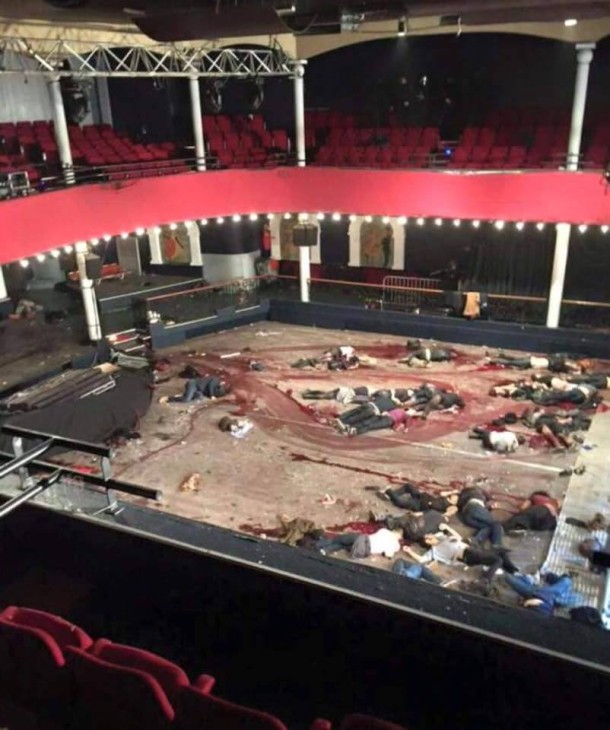
In November 2015, multiple terrorist attacks were carried out across Paris. The most deadly of these attacks took place at the Bataclan theatre, during an Eagles of Death Metal show. 129 people were killed and 352 wounded. ISIS claimed responsibility for this attack and the others that took place throughout Paris.
Romanian nightclub fire leaves 27 dead, scores injured
Hundreds of young people were packed into a music club in central Bucharest, Romania, jamming to the head-pounding heavy metal music filling their ears.
It was almost Halloween. The band, Goodbye to Gravity, was celebrating a new album with a free concert. For the young partygoers life was awesome.
But suddenly the 300 or 400 people were scrambling toward the one exit at Colectiv, a club built inside a Communist-era factory.
Witnesses say pyrotechnics sparked a fire that quickly became a widespread blaze with dark, blinding smoke. Authorities say the cause is something that needs to be figured out.
At least 27 people died and 162 were injured when the blaze broke out late Friday, authorities said.
A spokeswoman for the Interior Ministry, Monica Dajbog said many of the injured — who were taken to 12 hospitals — were in critical condition.
A prosecutor and fire specialists will investigate the scene and determine how the fire started, she said.
Goodbye to Gravity was having an album release concert, the group said on its social media pages.
Paul Angelescu, a reporter with ProTV, said the mayor told him the club had all the necessary permits to operate as a club.
Romanian President Klaus Iohannis said he was “shocked and deeply saddened” by the news.
“It is a very sad moment for all of us, for our nation and for me personally,” he said in a post to his Facebook page.
The fire appears to be the deadliest nightclub blaze since a 2013 fire at a nightclub in Santa Maria, Brazil, killed 235 people.
Guns N Roses Buenos Aires
The first of three appearances this band makes on the list (just wow), and the only one with theChinese Democracy lineup. Guess the guys didn’t lose the sense of pissing people off as time went buy. Last year in Buenos Aires, people started doing shit after they couldn’t get tickets to get in (hilarious, I know). Police were called in to stop the violence, 12 people were arrested.
